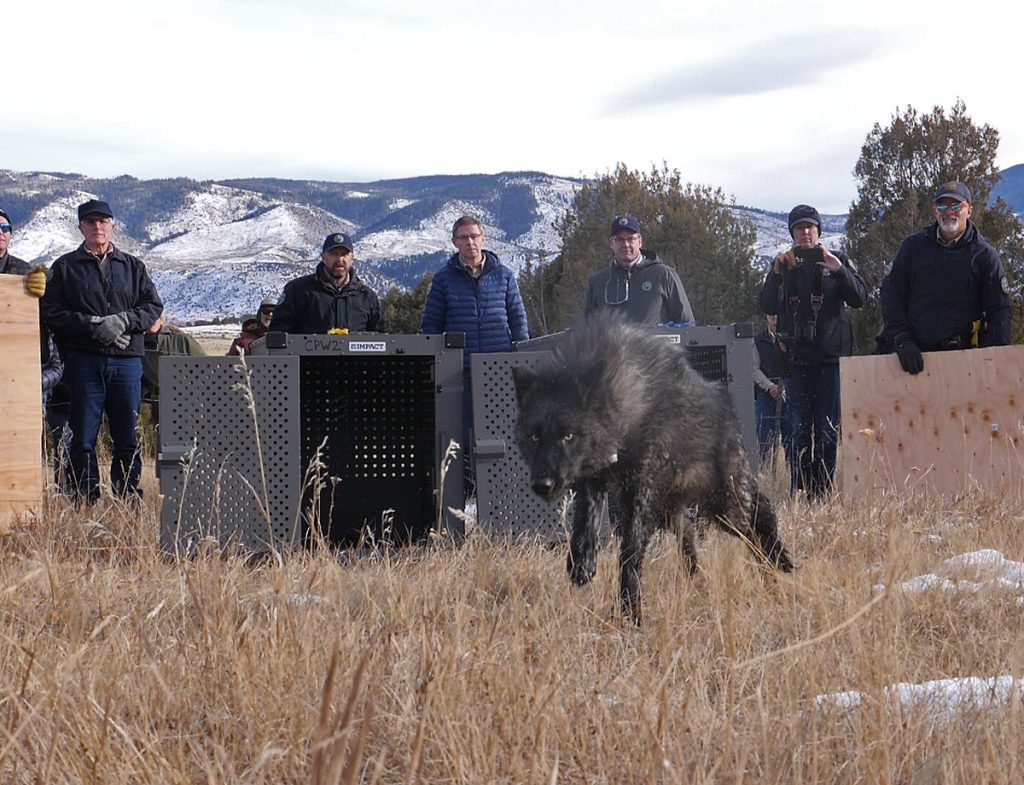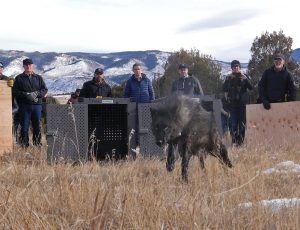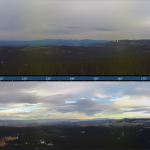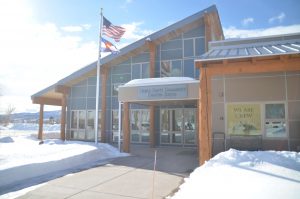Colorado forges ahead with winter wolf release amid federal, local headwinds

Colorado Parks and Wildlife/Courtesy Photo
Despite percolating challenges to Colorado’s wolf restoration, Colorado Parks and Wildlife is forging ahead with plans for a third release of the animals this winter.
The state wildlife agency is nearly two years into the voter-mandated wolf reintroduction program, releasing 25 animals since December 2023. Parks and Wildlife’s wolf management plan recommends that the agency release 30 to 50 wolves in the program’s first three to five years. In sticking to this plan, the agency has been seeking a source for up to 15 more wolves to release this winter.
However, this third release has been met with roadblocks, including continued requests from producers and lawmakers to pause the program, as well as the Trump administration introducing new limits on where the wolves can come from.
In October, the newly-appointed U.S. Fish and Wildlife Service Director Brian Nesvik told Parks and Wildlife Director Jeff Davis in a letter that Colorado could only source wolves from northern Rockies states where gray wolves are not listed as endangered. This includes Idaho, Montana, Wyoming and portions of Oregon, Washington and Utah.
Nesvik argued that sourcing wolves from outside these areas violates the 10(j) agreement Parks and Wildlife has with the federal agency to manage an experimental population of the animals in Colorado.
Environmental advocates, including Earthjustice and Defenders of Wildlife, have pushed back on this claim, arguing that while the agreement names these states as the “preferred” source of wolves, it does not prevent the state from using other sources.
Before the letter, Parks and Wildlife had not only worked with Fish and Wildlife on its January release of 15 wolves from British Columbia, but the state agency had entered into an agreement with British Columbia’s Ministry of Water, Land and Resource Stewardship to obtain the next 10 to 15 animals this winter. Luke Perkins, a spokesperson for Parks and Wildlife, said the state wildlife agency had also worked with Fish and Wildlife on the latest agreement.
At this week’s Parks and Wildlife Commission meeting, Davis said that while the Parks and Wildlife has a “a different interpretation than Director Nesvik and the Trump administration” on what the agreement says about wolf sources, the agency is working to “source consistent with Director Nesvik’s letter.”
“When there’s changes in federal administrations, we can see different interpretations,” Davis said. “We are working very diligently to be consistent with the letter that I received from Director Nesvik at U.S. Fish and Wildlife Service, and we’ll continue to work to implement our Wolf Restoration and Management Plan, which means another round of up to 15 animals for this next season.”
Perkins said the state is “evaluating all options to support this year’s gray wolf releases” and “has continued conversations with several potential sources in order to maximize Colorado’s options.”
This includes the Washington Department of Fish and Wildlife, which will discuss Colorado’s request for wolves at a meeting on Saturday, Nov. 15.
Petition for pause on wolves hits roadblock
While the agency works against the federal headwinds, it is also dealing with pushback from Colorado ranchers and communities.
Parks and Wildlife’s Nov. 13 commissioner meeting opened with a robust discussion around citizen petitions when Commissioner Tai Jacober, who is also a Carbondale producer, requested that the board hear a petition this week to pause this winter’s anticipated wolf release.
The discussion flared to include questions around two citizen petitions involving the agency’s furbearer regulations — one requesting more data on bobcats, beavers and foxes and a second requesting a ban on commercial fur sales — and ended with frustration from Parks and Wildlife staff over increasing workloads and stress.
Typically, it takes months for petitions to be heard by the commission. For example, one of the furbearer petitions was submitted in November 2024 and will not be heard until March, when Parks and Wildlife takes up other regulatory changes surrounding furbearers. After a submission, Parks and Wildlife staff prepare a recommendation for the commission, which the board can approve or deny.
The wolf petition — submitted by a group of 29 agricultural groups, hunting organizations and county commissioners to Parks and Wildlife in September — requested that the agency hold off on any wolf releases until November 2026. The petitioners argue that the one-year pause would allow time for the agency to address the wolf program’s current shortfalls — which the groups claim include resource, communication and funding concerns — as well as better reduce conflict between wolves and livestock.
This petition mirrored one submitted to the Parks and Wildlife Commission in September 2024 that the board denied in January, just days before it released its first wolves from British Columbia. A dozen groups signed onto both petitions.
The latest petition asked the agency to decide by its October or November meetings, before the next release. The commission’s next meeting will be held in January.
While the first two wolf releases took place in northwest Colorado in December and January, the next will take place in the southwest in “the upcoming winter months,” according to Perkins.
Jacober’s request to hear the petition this week was met with concerns from commissioners that it was not proper procedure to hear citizen petitions and that the petition’s request was moot.
Commissioner Murphy Robinson expressed that doing so could have ramifications, should the commission begin prioritizing certain petitions over others, particularly without staff input.
“I worry that we will get in some type of loop of chaos if we don’t abide by our own rules,” Robinson said.
Richard Reading, chair of the Parks and Wildlife Commission, said that the board’s policies allow it to “disfavor” previously denied petitions that are resubmitted within a calendar year unless there’s new and substantial information added.
“We denied a similar petition at our January meeting,” Reading said. “We had sound reasons for denying that petition at that time.”
Reading expressed further concerns over how much of the commission and wildlife agency’s time is dedicated to wolves.
“I think we have other matters to discuss,” Reading said. “Addressing the position at this meeting would require us and the division to take time away from other important matters. If we turn every meeting into a referendum on wolves, we’re not going to get much done. So I would argue that we should address this petition in due course at a later date.”
On Friday, Andy Spann, president of the Gunnison County Stockgrowers’ Association, one of the petitioning organizations, pushed for the commission to hear the petition before another release and warned of potential consequences.
“How does slow walking the petition build trust?” Spann said. “While some may consider the efforts by producers and others from across the state as fighting and not cooperating, producers have cooperated and partnered with (Parks and Wildlife) for decades….Cooperation and relationships are not only up to staff on the ground but can be greatly affected by the actions of this commission.”
As the discussion swelled to include a motion from Commissioner Jess Beaulieu to hear two furbearer petitions in January 2026, two months earlier than the agency plans to bring them forward, staff expressed frustration over the commissioner’s motions.
“We have staff working extremely hard on a number of topics right now,” said Brian Dreher, Parks and Wildlife’s assistant director. “Doing this out of order in terms of how we had this planned, it really impacts us. And to be truthful with you, it’s really tough on staff. This is not a great move for us to just kind of change everything that we have going with no heads up for that matter.”
Davis addressed this mounting frustration and stress among Parks and Wildlife staff later in the meeting.
“So, so many of us are just ground down right now,” Davis said, appearing to get choked up. “There’s great people that are just trying to hang on right now. We’re going to hang on together and get through it, but it’s a lot. I’ve never seen anything like it. It’s a massive workload in a very short period of time that seems to be speeding up.”
Ultimately, neither motion was voted on.
While Davis acknowledged the ongoing concerns and fears from livestock producers about living with wolves, he also listed all that Parks and Wildlife has done and is doing to minimize the conflict.
This includes conducting over 230 site assessments to provide individualized conflict minimization recommendations to producers, providing conflict prevention materials to 35 different producers, constructing storage facilities in the southwest for these materials, requesting funds to hire 12 new range riders in the southwest for next year, improving its compensation program for wolf-related losses and more.
“Part of the success of the implementation of this law is not just a sustainable population of wolves — we will get there — it’s also to make sure that we’re taking care of those potential conflicts with livestock in the industry that has a lot of uncertainties that they’re navigating now,” Davis said.

Support Local Journalism

Support Local Journalism
Readers around Steamboat and Routt County make the Steamboat Pilot & Today’s work possible. Your financial contribution supports our efforts to deliver quality, locally relevant journalism.
Now more than ever, your support is critical to help us keep our community informed about the evolving coronavirus pandemic and the impact it is having locally. Every contribution, however large or small, will make a difference.
Each donation will be used exclusively for the development and creation of increased news coverage.










